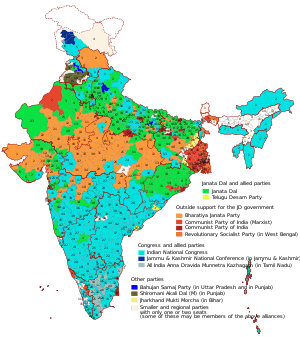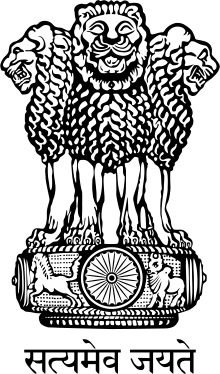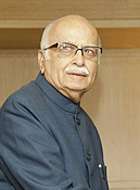1989 Indian general election
General elections were held in India in 1989 to elect the members of the 9th Lok Sabha.[2] V. P. Singh united the entire disparate spectrum of parties including regional parties such as the Telugu Desam Party, the Dravida Munnetra Kazhagam, and the Asom Gana Parishad, forming the National Front with N.T.Rama Rao as president and V. P. Singh as convenor with additional outside support from the Bharatiya Janata Party and Communist Party of India (Marxist) led Left front they defeated Rajiv Gandhi's Congress (I) in the 1989 parliamentary elections.[3][4]
| |||||||||||||||||||||||||||||||||||||
All 545 seats in the Lok Sabha 273 seats were needed for a majority | |||||||||||||||||||||||||||||||||||||
|---|---|---|---|---|---|---|---|---|---|---|---|---|---|---|---|---|---|---|---|---|---|---|---|---|---|---|---|---|---|---|---|---|---|---|---|---|---|
| Turnout | 61.95% ( | ||||||||||||||||||||||||||||||||||||
| |||||||||||||||||||||||||||||||||||||
 | |||||||||||||||||||||||||||||||||||||
| |||||||||||||||||||||||||||||||||||||
Background
The 1989 Indian general election were held because the previous Lok Sabha has been in power for a five years, and the constitution allowed for new elections. Even though Rajiv Gandhi had won the last election by a landslide, this election saw him trying to fight off scandals that had marred his administration.
The Bofors scandal, rising terrorism in Punjab, the civil war between LTTE and Sri Lankan government were just some of the problems that stared at Rajiv's government. Rajiv's biggest critic was Vishwanath Pratap Singh, who had held the portfolios of the finance ministry and the defence ministry in the government.
But Singh was soon sacked from the Cabinet and he then resigned from his memberships in the Congress and the Lok Sabha. He formed the Jan Morcha with Arun Nehru and Arif Mohammad Khan and re-entered the Lok Sabha from Allahabad. Witnessing V P Singh's meteoric rise on national stage, Rajiv tried to counter[5] him with another prominent Rajput stalwart Satyendra Narain Singh but failed eventually.
Premiership
V. P. Singh as Prime Minister
V. P. Singh, who was the head of the Janata Dal, was chosen leader of the National Front government.[6] His government fell after Singh, along with Bihar's Chief Minister Lalu Prasad Yadav's government, had Advani arrested in Samastipur and stopped his Ram Rath Yatra, which was going to the Babri Masjid site in Ayodhya on 23 October 1990. Bharatiya Janata Party withdrew their support to Singh government, causing them to lose parliamentary vote of confidence on 7 November 1990.[7]
Chandra Sekhar as Prime Minister
Chandra Shekhar broke away from the Janata Dal with 64 MPs and formed the Samajwadi Janata Party in 1990. He got outside support from the Congress and became the 9th Prime Minister of India. He finally resigned on 21 June 1991, after the Congress alleged that the government was spying on Rajiv Gandhi.
 |
|---|
| This article is part of a series on the politics and government of India |
|
National coalitions
|
|
|
Results
| Lok Sabha elections 1989 Electoral participation: 61.95% |
% | Won (total 545) | |
|---|---|---|---|
| Bharatiya Janata Party | BJP | 11.36 | 85 |
| Communist Party of India | CPI | 2.57 | 12 |
| Communist Party of India (Marxist) | CPI(M) | 6.55 | 33 |
| Indian Congress (Socialist) | IC(S) | 0.33 | 1 |
| Indian National Congress | INC | 39.53 | 197 |
| Janata Dal | JD | 17.79 | 143 |
| Janata Party | JP | 1.01 | 0 |
| Lok Dal (Bahuguna) | LD(B) | 0.2 | 0 |
| All India Anna Dravida Munnetra Kazhagam | AIADMK | 1.5 | 11 |
| All India Forward Bloc | AIFB | 0.42 | 3 |
| Dravida Munnetra Kazhagam | DMK | 2.39 | 0 |
| Indian Congress (J) Trikha Group | ICJ(TG) | 0.0 | 0 |
| Indian Union Muslim League | IUML | 0.32 | 2 |
| Jammu & Kashmir National Conference | NC | 0.2 | 3 |
| Jammu & Kashmir Panthers Party | JPP | 0.0 | 0 |
| Kerala Congress | KC | 0.02 | 0 |
| Kuki National Assembly | NC | 0.04 | 0 |
| Maharashtrawadi Gomantak Party | MGP | 0.04 | 1 |
| Manipur Peoples Party | MPP | 0.05 | 0 |
| Mizo National Front | MNF | 0.02 | 0 |
| Nagaland Peoples Council | NPC | 0.08 | 0 |
| Peoples Party of Arunachal | PPA | 0.3 | 0 |
| Peasants and Workers Party of India | PWPI | 0.21 | 0 |
| Revolutionary Socialist Party | RSP | 0.62 | 4 |
| Shiromani Akali Dal | SAD | 0.03 | 0 |
| Shiromani Akali Dal (Badal) | SAD(B) | 0.14 | 0 |
| Sikkim Sangram Parishad | SSP | 0.03 | 1 |
| Telugu Desam Party | TDP | 3.29 | 2 |
| Akhil Bharatiya Hindu Mahasabha | ABHS | 0.07 | 1 |
| All India Majlis-e-Ittehadul Muslimen | AIMIM | 0.21 | 1 |
| Bahujan Samaj Party | BSP | 2.07 | 3 |
| Gorkha National Liberation Front | GNLF | 0.14 | 1 |
| Indian Peoples Front | IPF | 0.25 | 1 |
| Jharkhand Mukti Morcha | JMM | 0.34 | 3 |
| Kerala Congress (Mani) | KC(M) | 0.12 | 1 |
| Marxist Coordination Committee | MCO | 0.08 | 1 |
| Shiromani Akali Dal (Simranjit Singh Mann) | SAD(M) | 0.77 | 6 |
| Shiv Sena | SS | 0.11 | 1 |
| Independents | – | 5.25 | 12 |
| Nominated Anglo-Indians | – | – | 2 |
9th Lok Sabha constituted.[8]
References
- "INDIA: Parliamentary elections Lok Sabha, 1989".
- "Elections 1989: Congress(I) faces prospect of being routed in Bihar".
- "V. P. Singh, a Leader of India Who Defended Poor, Dies at 77". The New York Times. 29 November 2008.
- Indian Parliamentary Democracy. Atlantic Publishers & Dist. 2003. p. 124. ISBN 978-81-269-0193-7.
- "The Tribune, Chandigarh, India - Opinions".
- "V. P. Singh: Prime Minister of India who tried to improve the lot of the poor". The Independent. 19 December 2008. Retrieved 6 October 2017.
- "India's Cabinet Falls as Premier Loses Confidence Vote, by 142–346, and Quits". The New York Times. 8 November 1990.
- "Archived copy" (PDF). Archived from the original (PDF) on 18 July 2014. Retrieved 25 May 2014.CS1 maint: archived copy as title (link)
.jpg)
.jpg)
